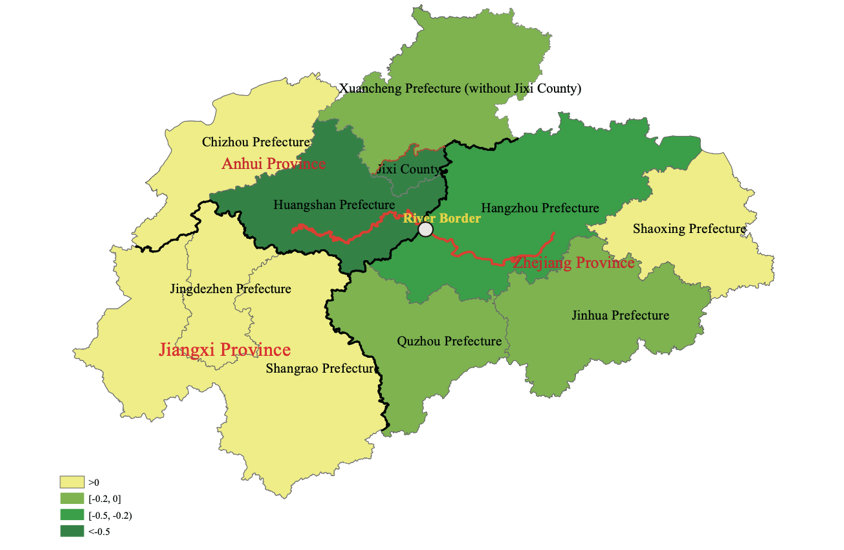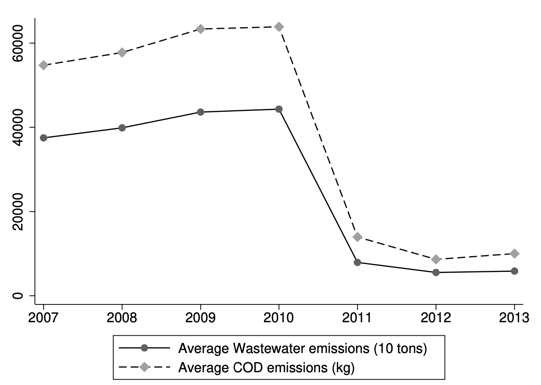Combating Cross-Border Externalities
China implemented a pioneering policy in 2011, the Ecological Compensation Initiative (ECI), which establishes side payments between upstream and downstream provinces in the Xin’an River Basin. Evidence shows that the ECI mitigates cross-border externalities by sharply reducing water pollutant emissions from upstream firms and induces firms’ relocation to neighboring cities. Programs later established in other rivers confirm the broader applicability of ECI, despite its dependence on the discrepancy in wealth and economic structure between upstream and downstream regions.

C ross-border river pollution is a common issue worldwide, creating a great challenge for regulators. When polluters are located in the same administrative jurisdiction, local regulations may be sufficient to balance their respective benefits and costs. However, when an administrative border separates these parties, local regulators may fail to consider the portion of damages that accrue to water users in downstream jurisdictions, resulting in excessively lenient regulations. Due to this dynamic, firms may choose (or be encouraged) to locate near jurisdictional boundaries so that the bulk of their pollution damages consist of such "spillovers."
However, since nearly all of the existing instruments are applied at the locality level, rather than at the firm level, they are susceptible to border effects. Most commonly, by strategically relocating polluters toward boundary areas through differential regulation, local governments can improve their jurisdictional environmental quality for any given quantity of pollution, at the cost of downstream areas. This phenomenon is prevalent in China (Cai, Chen, and Gong 2016; Zhang, Chen, and Guo 2018) and other countries (Gray and Shadbegian 2004, Helland and Whitford 2003), as well as among countries (Sigman 2002, Wolf 2007). Although the problem is widely understood, few effective solutions have been offered.
The Xin’an runs for 359 km, from Huangshan Prefecture and Jixi County of Xuancheng Prefecture, both in the less-developed Anhui province, into Qiandao Lake in the wealthy, coastal Zhejiang Province (Figure 1). The serious blue-green algae outbreaks in Qiandao Lake in the first decade of the 21st century called national attention to the lake and to the problem of water pollution in the Xin’an River. In 2011, to improve water quality in the downstream length of the Xin’an, China established the first inter-jurisdictional ecological compensation mechanism in the Xin’an River Basin, the Ecological Compensation Initiative (ECI), designed to facilitate upstream–downstream cooperation in water pollution regulation. A fund was set up, jointly financed by the central government (contributing 300M RMB per year), Anhui Province (100M), and Zhejiang Province (100M). The two provinces made an agreement on compensation for ecological services provided by Anhui Province to clean the river. As a base payment, the 300 million RMB from the central government would be paid to Anhui to support its water conservation. If Anhui attained the agreed-upon cross-border water quality target based on the pollution reading at the borderline—one that exceeds federally mandated standards—Zhejiang would pay 100 million to Anhui to compensate its inputs in water quality control; otherwise, Anhui would pay 100 million to Zhejiang for ecological loss due to its failure in upstream water protection.

Figure 1: Reduction in Wastewater Discharge of Prefectures around the Xin’an River Basin after 2011.
Notes: The red line shows the Xin’an River and the green dot marks the river boundary between Anhui Province and Zhejiang Province. Colors show the percentage reductions in wastewater discharge in 2011–2013 relative to 2008–2010.
The ECI brought about favorable changes in cities’ water pollution, as is shown in Figure 1. Prefectures located closer to the Xin’an River reduced water pollutants by a greater proportion after the initiative was implemented. As the target cities, Huangshan Prefecture and Jixi County in upstream Anhui made larger proportional reductions than Hangzhou Prefecture, further downstream, while the neighboring area adjacent to target cities showed no sign of reducing pollution. The significant reduction in pollution is also observed in firm data, as shown in Figure 2.

Figure 2: Water Pollutant Emissions from Anhui Firms Along the Xin’an River from 2007 to 2013.
We found solid evidence of the effectiveness of the ECI. By employing a difference-in-differences strategy with the firm-level pollution data from the Annual Environmental Survey of Polluting Firms, we find that the implementation of the ECI is positively associated with an increased probability of upstream firms reducing water pollution after 2011, and the effect could be explained by both scale effect (decreased output) and technique effect (lowered pollution intensity). Upstream firms’ reduction in total water and fresh water inputs, increased pollution treatment facilities, and lowered water pollution generated during the production process account for the pollution reduction effect of the ECI.
The effect of ECI is heterogenous for firms located with different proximity to the river and to the boundary. We find that the closer firms are to the provincial border and the river tributary, the stronger the impact. Next, we extend our discussion to examining other implications of this new approach to addressing cross-border externalities. We find a significant increase in firm exits from the focal areas but a significant increase in the entry of industrial firms to neighboring prefectures. These results indicate that firms tend to leave areas executing the ECI then relocate to neighboring areas with comparatively more lenient regulations, which, to a certain extent, verifies an “internal” variant of the polluting havens hypothesis. We also find consistent evidence of greater water pollution increases in areas where more firms entered.
It is also interesting that the Xin’an River ECI has broader applicability in other watersheds. We closely examine later compensation schemes in nine other cross-provincial river basins, covering 12 different provinces across China, such as Beijing, Tianjin, Guangdong, Guangxi, Hunan, and Guizhou, among others, to test their effectiveness and identify determinants that might account for that effectiveness in this region. We find that similar arrangements also effectively reduce water pollution from the upstream prefectures. The ECIs also induce more firms to exit from the upstream markets and impede firms’ entry into these markets. Moreover, these results are significantly driven by a higher level of prosperity in downstream prefectures relative to upstream prefectures, perhaps reflecting some arbitrage between differences in the marginal utility of income across locales. The region’s economic structure also influences the effectiveness of the ECI: upstream prefectures with less reliance on industrial production and a larger proportion of tourism saw sharper reductions in water pollution.
An important takeaway from our study is that the ECI as a semi-market regulatory tool combines characteristics of traditional command-and-control and market methods, which make it effective to handle the cross-border spillover effect under the scenario that the downstream stakeholders and the upstream ecological service providers are massive and dispersed. Our findings suggest that bilateral compensation for ecosystem services successfully reduces pollution and that the upstream province is willing to reduce net income in exchange for reduced pollution, as the theory suggests. Although previous studies indicate that bargaining between upstream and downstream parties may be inefficient due to the large transaction costs associated with bargaining across jurisdictions (Dinar 2006; Sigman 2002), our results suggest that the ECI may be a promising model for cases in which jurisdictional boundaries are nested within a larger national jurisdictional authority that can nudge the parties toward a Coasian solution.
References
Cai, Hongbin, Yuyu Chen, and Qing Gong. 2016. “Polluting Thy Neighbor: Unintended Consequences of China’s Pollution Reduction Mandates.” Journal of Environmental Economics and Management 76: 86–104. https://doi.org/10.1016/j.jeem.2015.01.002.
Dinar, Shlomi. 2006. “Assessing Side-Payment and Cost-Sharing Patterns in International Water Agreements: The Geographic and Economic Connection.” Political Geography 25 (4): 412–37. https://doi.org/10.1016/j.polgeo.2006.03.007.
Gray, Wayne B., and Ronald J. Shadbegian. 2004. “‘Optimal’ Pollution Abatement—Whose Benefits Matter, and How Much?” Journal of Environmental Economics and Management 47 (3): 510–34. https://doi.org/10.1016/j.jeem.2003.01.001.
Helland, Eric, and Andrew B. Whitford. 2003. “Pollution Incidence and Political Jurisdiction: Evidence from the TRI.” Journal of Environmental Economics and Management 46 (3): 403–24. https://doi.org/10.1016/S0095-0696(03)00033-0.
Lipscomb, Molly, and Ahmed Mushfiq Mobarak. 2016. “Decentralization and Pollution Spillovers: Evidence from the Re-drawing of County Borders in Brazil.” Review of Economic Studies 84 (1): 464–502. https://doi.org/10.1093/restud/rdw023.
Sigman, Hilary. 2002. “International Spillovers and Water Quality in Rivers: Do Countries Free Ride?” American Economic Review 92 (4): 1152–59. https://doi.org/10.1257/00028280260344687.
Wolf, Aaron T. 2007. “Shared Waters: Conflict and Cooperation.” Annual Review of Environment and Resources 32: 241–69. https://doi.org/10.1146/annurev.energy.32.041006.101434.
Zhang, Bing, Xiaolan Chen, and Huanxiu Guo. 2018. “Does Central Supervision Enhance Local Environmental Enforcement? Quasi-experimental Evidence from China.” Journal of Public Economics 164: 70–90. https://doi.org/10.1016/j.jpubeco.2018.05.009.

Latest
Most Popular
- VoxChina Covid-19 Forum (Second Edition): China’s Post-Lockdown Economic Recovery VoxChina, Apr 18, 2020
- China’s Great Housing Boom Kaiji Chen, Yi Wen, Oct 11, 2017
- China’s Joint Venture Policy and the International Transfer of Technology Kun Jiang, Wolfgang Keller, Larry D. Qiu, William Ridley, Feb 06, 2019
- The Dark Side of the Chinese Fiscal Stimulus: Evidence from Local Government Debt Yi Huang, Marco Pagano, Ugo Panizza, Jun 28, 2017
- Wealth Redistribution in the Chinese Stock Market: the Role of Bubbles and Crashes Li An, Jiangze Bian, Dong Lou, Donghui Shi, Jul 01, 2020
- What Is Special about China’s Housing Boom? Edward L. Glaeser, Wei Huang, Yueran Ma, Andrei Shleifer, Jun 20, 2017
- Evaluating Risk across Chinese Housing Markets Yongheng Deng, Joseph Gyourko, Jing Wu, Aug 02, 2017
- Privatization and Productivity in China Yuyu Chen, Mitsuru Igami, Masayuki Sawada, Mo Xiao, Jan 31, 2018
- How did China Move Up the Global Value Chains? Hiau Looi Kee, Heiwai Tang, Aug 30, 2017
- China’s Shadow Banking Sector: Wealth Management Products and Issuing Banks Viral V. Acharya, Jun Qian, Zhishu Yang, Aug 09, 2017




 Facebook
Facebook  Twitter
Twitter  Instagram
Instagram WeChat
WeChat  Email
Email 


